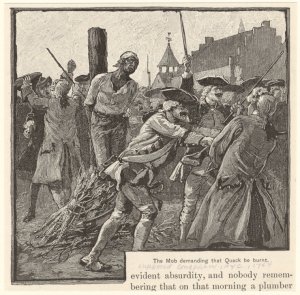Today I have taken from the voluminous pages of New York City's rich and turbulent history, "The Negro Riot of 1712."


THE FIRST DISTURBANCE of any consequence happened in 1712, when the City hardly extended above Wall-street. About a quarter of the inhabitants were slaves, and a considerable number more were free negroes.
1These people were kept under strict surveillance, and severe punishments were given for slight offenses. But they were badly influenced by the crews of vessels frequenting the port, and always ripe for mischief.
On the 7th of April, 1712, at 1 o'clock in the morning, the house of Peter Van Tilburgh was fired by negroes, and the fire was the signal for a revolt. The White men who hurried to put out the fire were met by a mob of negroes, and several whites were killed. The rest fled and alarmed the fort, a cannon was fired as a signal, and the British troops quickly turned out. The sight of bayonets was too much for the negroes, and they fled to the woods and swamps in the region of the present City Hall Park and Canal street.
Eight or 10 whites were killed, as were many negroes. The number of the latter can only be inferred from the statement of a historian, who incidentally remarks: "During the day 19 more were taken, tried, and executed. Some that turned State's evidence were transported." For the period and the whole number of inhabitants, the riot was a great one, and the loss of life equal to a loss of 5,000 lives today.
2 In 1711 a slave market opened at the eastern end of Wall Street. The Negroes were treated so badly that they became sullen. Tension developed between them and their masters. A Negro woman and an Indian man were burned at the stake in New York City for murdering their master, mistress, and five children. Negroes were not encouraged to embrace Christianity because most whites believed they lacked souls. Marriages between Negroes were performed by mutual consent and did not receive the blessing of the Church.
About 1 A.M. on April 7, 1712, twenty-three Negroes gathered in an orchard in Maiden Lane. They were armed with guns, hatchets, and knives. By launching a dramatic revolt, they hoped to incite other slaves and massacre all the white people in town. They set fire to the house of Peter Van Tilburgh. As the flames reached to the sky, all twenty-three conspirators marched toward the fire. Governor Hunter was awakened and told that the slaves had revolted. He ordered a cannon fired from the fort to alert the townspeople and dispatched soldiers to the disturbed area. The town was filled with rage and fear. Some of the negroes that were caught were tortured and killed. Some were burned alive over a slow fire. A total of 21 Negroes were executed.
Source of Information: 1) New York Times July 29, 1877; 2) The Epic of New York City Edward Robb Ellis, Old Town Books 1966 (excerpt)
To contact: miriam@thehistorybox.com or miriammedina@earthlink.net
.

No comments:
Post a Comment